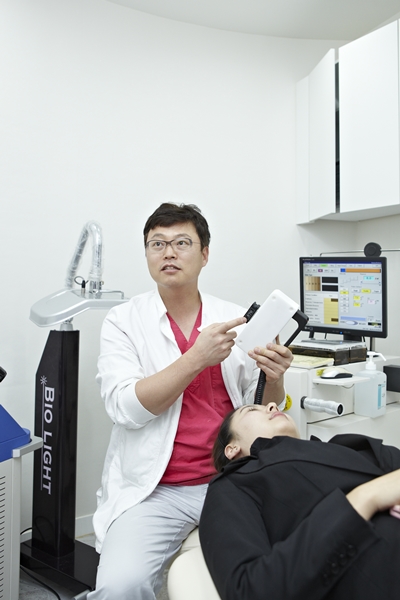▶ Previous Artlcle : [Issue] Laser Training with Clinical Experience of Wound Care and Anatomical Knowledge – Plastic Surgery V

Dr. Geun-shik Shin of Shinseung Plastic Surgery emphasizes that plastic surgeons should not underestimate the effect of laser.
“I mostly focus on surgery and do not prefer laser. But I do think that a doctor should be proficient in many tools to better satisfy patients’ various needs. In that sense, laser provides a relatively easy method to attain certain goals. The biggest challenge with laser is pigmentary lesions. When it comes to pigmentary lesions, dermatologists seem to be more knowledgeable and equipped with specialized knowhow. I try to offer wider treatment options to my patients and have branched into laser toning and pigment treatment with yellow laser. I also find fractional laser effective on fine lines that are not easily corrected with thread lift.”
How to become a surgeon with expertise in laser
HELIOSⅡ/LOTUSⅡ/HYPERION – Manufacturer: LASEROPTEK(www.laseroptek.com)
Dr. Eul-sik Yoon, Professor of Dermatology, Korea University Anam Hospital, says, “University hospitals need to offer more systematic training in laser.”
“Currently, laser training remains at a basic level. To make plastic surgeons more familiar with laser, more systematic and extensive training programs in laser are needed. Junior doctors who are starting their training in laser should not be afraid to use the device. Starting with scar removal, a simple and common procedure in plastic surgery, to go on to the more challenging pigmentary lesions will help them better adjust to the techniques.”
Dr. Soo-young Cho of Cho Cosmetic Clinic stresses that “one must extensively study the theory of laser before using the device.”
“Brushing up on the basic principles of laser and extensively reading about treatment method for different lesions and precautions, etc. will help you avoid mistakes. As newer devices are safer, laser therapy has become easier to approach. Doctors tend to irradiate the site of side effects with laser again but most side effects from laser do resolve naturally with time. When side effects occur, avoid additional stimulation and provide soothing post-laser care.”
Dr. Jae-woo Park of Dr. Park Plastic Surgery explains that “Training in laser is similar to learning how to drive.”
“We spend a lot of time and effort receiving driving instruction to get the driver’s license. But we actually become seasoned drivers after we gain experience driving on the road. Likewise, laser is taught in medical school but to be proficient in laser therapy, one needs to work hard and accumulate a lot of experience. It is important to first understand the exact needs of the patients. It would be unwise to purchase a pigment laser device when no patient presents with pigmentary lesions. Have the right devices available for your particular set of patients and accumulate a lot of practical experience to develop special knowhow. Once you become comfortable with basic devices, you will go through a shorter learning curve when you add new devices. Becoming proficient in a few devices will naturally allow you to later combine them together for enhanced effect.”
Dr. Jae-goo Choi, Professor of Plastic Surgery, Hallym University Medical Center, advises that “it would help plastic surgeons to study laser as part of expanding their specialty.”
“Start out slowly and cautiously sticking to a few clear-cut indications for each laser. This will help plastic surgeons expand their horizons and overcome the drawbacks of surgery.”
-The end-




















